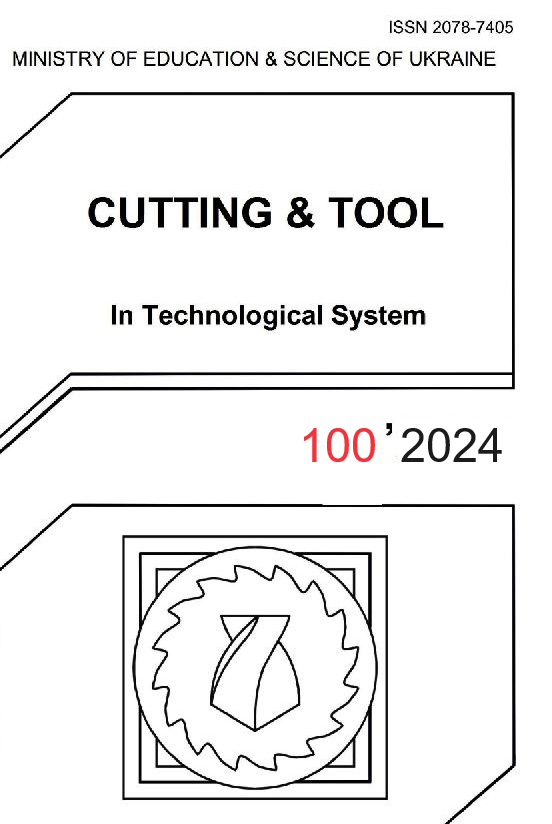FINITE ELEMENT ANALYSIS OF CHANGING OF STRESS CONDITION CAUSED BY DIAMOND BURNISHING
DOI:
https://doi.org/10.20998/2078-7405.2024.100.10Keywords:
finite element modelling, diamond burnishing, surface integrity, plastic deformationAbstract
The article is aspected to the finite element modelling of stress in subsurface layer of aluminium alloy workpiece during diamond burnishing process. This cold forming process is a simple, cost-effective finishing method that can be used to improve surface integrity and provide compressive residual stress. Available with these, durability and quality enhancement of the components can be reached, but improperly chosen burnishing parameters can distort the efficiency of the plastic deformation process. In order to optimize this, a 2D FEM model is created including the real surface integrity of the workpiece which was measured with AltiSurf 520 surface roughness measuring device. The method is simulated using DEFORM-2D software, corresponding to the numerical values of burnishing parameters implemented in practice as well, thereby allowing a comparative analysis with the results of X-ray diffraction measurement.
References
I. Sztankovics: FEM Analysis of the Impact Conditions of the Insert in Face Milling, MultiScience ‒ XXXIII. MicroCAD International Multidisciplinary Scientific Conference , pp. 1‒8, 2019.
C. Felho, I. Sztankovics, Z. Maros, K. Kun-Bodnar: FEM Simulation of the Flange Turning in the Production of Aluminium Aerosol Cans, Manufacturing Technology 23, pp. 810‒818, 2023.
I. Sztankovics, G. Varga: FEM Analysis of the Burnishing Process of X5CrNi19-10 Stainless Steel, Rezanie i Instrument v Tehnologiceskikh Sistemakh / Cutting and Tool in Technological Systems, 97, pp. 137‒144, 2022.
T. Emmer, F. Welzel, D. Borysenko, V. Voropai: Development of the Mathematical Model Smoothing while Using FEA, Rezanie i Instrument v Tehnologiceskikh Sistemakh / Cutting and Tool in Technological Systems, 90, pp. 58‒68, 2019.
V. Fedorovich, I. Pyzhov, I. Voloshkina: Modeling of the Process of Vibratory Grinding by Finite Element Method, Rezanie i Instrument v Tehnologiceskikh Sistemakh / Cutting and Tool in Technological Systems, 90, pp. 136‒150, 2019.
Y.C. Yen, P. Sartkulvanich, T. Altan: Finite Element Modelling of Roller Burnishing Process, Engineering, Material Science, pp. 1‒4, 2005
C. Amini, R. Jerez-Mesa, J.A. Travieso-Rodriguez, J. Lluma, A. Estevez-Urra: Finite Element Analysis of Ball Burnishing on Ball-End Milled Surfaces Considering Their Original Topology and Residual Stress, Metals 638, pp. 1‒16, 2020.
C. Felho, G. Varga: 2D FEM Investigation of Residual Stress in Diamond Burnishing, Journal of Manufacturing and Materials Processing 123, pp. 1‒16, 2022.
D. Borysenko, F. Welzel, B. Karpuschewski, J. Kundrak, V. Voropai: Simulation of the Burnishing Process on Real Surface Structures, Precision Engineering 68, pp. 166‒173, 2021.
P. Balland, L. Tabourot, F. Degre, V. Moreau: Mechanics of the Burnishing Process, Precision Engineering 37, pp. 129‒134, 2012.
P. Balland, L. Tabourot, F. Degre, V. Moreau: An Investigation of Mechanics of Roller Burnishing Though Finite Element Simulation and Experiments, International Journal of Machine Tools & Manufacture 365, pp. 29‒36, 2013.
A. Skoczylas, K. Zaleski: Selected Properties of the Surface Layer of C45 Steel Parts Subjected to Laser Cutting and Ball Burnishing, Materials 3429, pp. 1‒19, 2020.
A. Saldana-Robles, H. Plascencia-Mora, E. Aguilera-Gomez, A. Saldana-Robles, A. Marquez-Herrera, J.A. Diosdado-De la Pena: Influence of Ball Burnishing on Roughness, Hardness and Corrosion Resistance of AISI 1045 Steel, Surface & Coatings Technology 339, pp. 191‒198, 2018.
E. Becerra-Becerra, C.O. Aguilera Ojada, A. Saladana-Robles, J.F. Reveles-Arredondo, J. Barco-Burgos, A. Vidal-Lesso: A Review of Numerical Simulation of Ball Burnishing Process, Finite Elements in Analysis and Design 218, pp. 1‒19, 2023.
M. Posdzich, R. Stöckmann, F. Morczinek, M. Putz: Investigation of a Plain Ball Burnishing Process on Differently Machined Aluminium EN AW 2007, MATEC Web of Conferences 190, pp. 1‒19, 2018.
D. Vukelic, D. Miljanic, S. Randjelovic, I. Budak, D. Dzunic, M. Eric, M. Pantic: A Burnishing Process Based on the Optimal Depth of Workpiece Penetration, Material and Technology 47, pp. 43‒51, 2013.
R. Stöckmann, M. Putz: Modelling of Surface Formation Mechanism during Burnishing of Aluminium, Procidia CIRP 82, pp. 450‒454, 2019.
A. Rodriguez, L.N. Lopez de Lacalle, A. Celeya, A. Lamikiz, J. Albizuri: Surface Improvement of Shafts by the Deep Ball-Burnishing Technique, Surface & Coatings Technology 206, pp. 2817‒2824. 2012.
C. Felho, G. Varga: 2D FEM Investigation of Residual Stress in Diamond Burnishing, Journal of Manufacturing and Materials Processing 123, pp. 1‒16. 2022.
V. Ferencsik: Analytical Analysis of the Theoretical Surface Roughness in the Case of Burnishing of Cylindrical Workpiece, Rezanie i Instrument v Tehnologiceskikh Sistemakh / Cutting and Tool in Technological Systems, 99, pp. 101‒109. 2023.
Downloads
Published
Issue
Section
License
Copyright Notice
Authors who publish with this Collection agree to the following terms:
1. Authors retain copyright and grant the Collection right of first publication with the work simultaneously licensed under a Creative Commons Attribution License that allows others to share the work with an acknowledgement of the work's authorship and initial publication in this Collection.
2. Authors are able to enter into separate, additional contractual arrangements for the non-exclusive distribution of the Collection's published version of the work (e.g., post it to an institutional repository or publish it in a book), with an acknowledgement of its initial publication in this Collection.
3. Authors are permitted and encouraged to post their work online (e.g., in institutional repositories or on their website) prior to and during the submission process, as it can lead to productive exchanges, as well as earlier and greater citation of published work.

